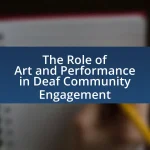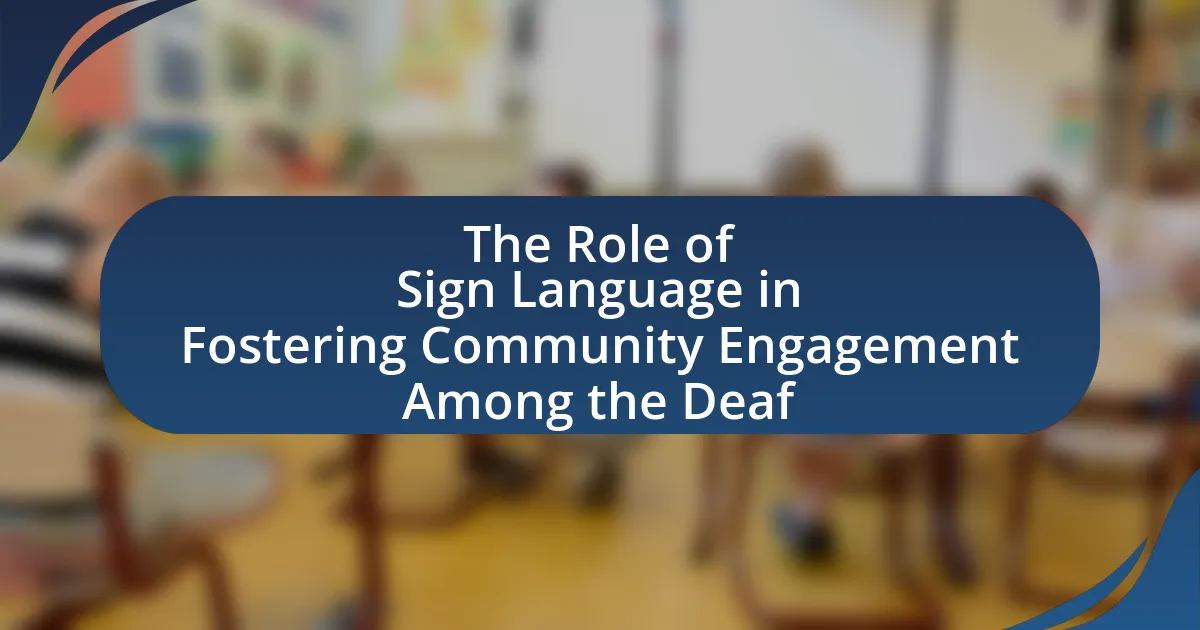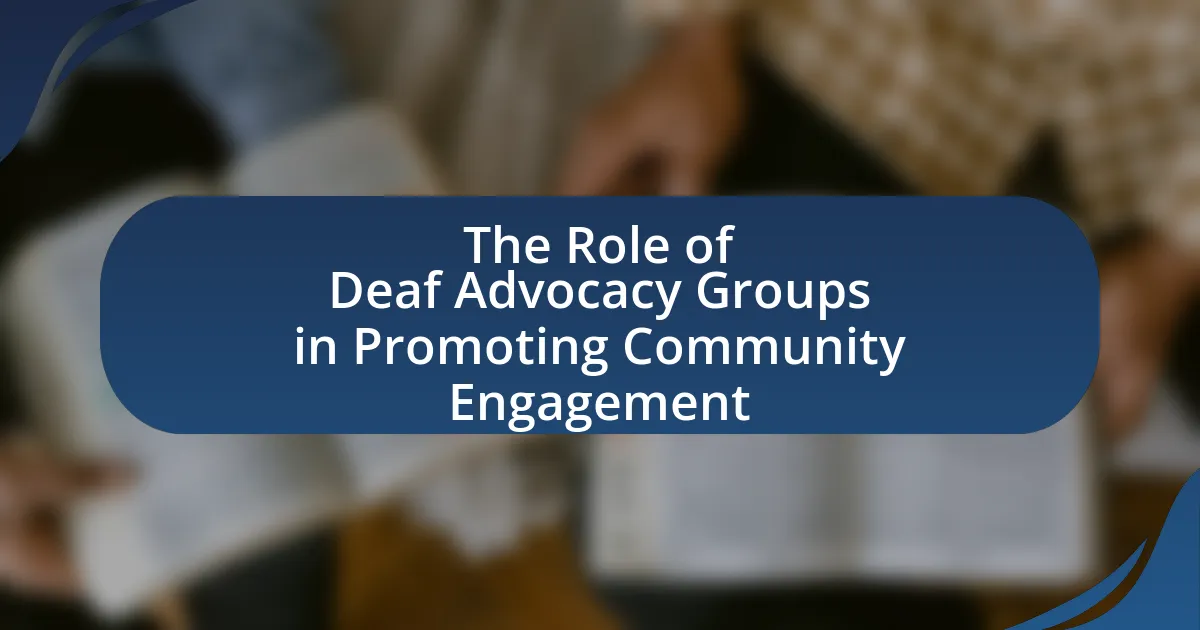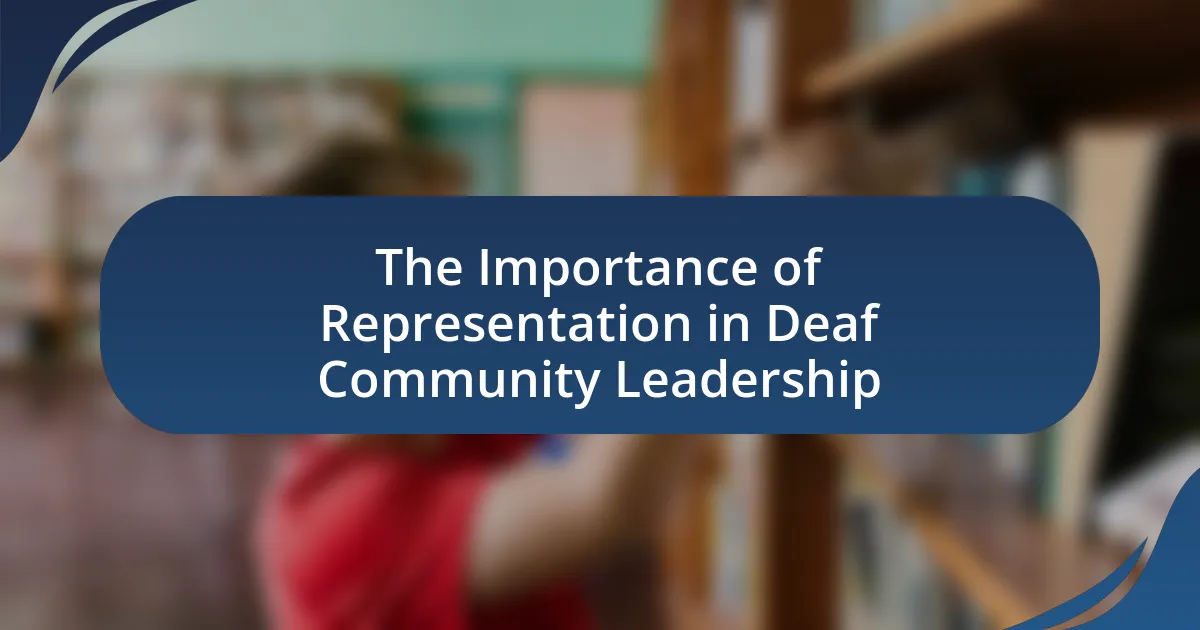Deaf Culture plays a crucial role in shaping community identity by fostering a sense of belonging through shared language, values, and social norms. Central to this culture is American Sign Language (ASL), which not only facilitates communication but also reinforces cultural heritage and community ties. The article explores how Deaf Culture influences individual identity, enhances social interactions, and promotes advocacy for rights and accessibility, while also addressing the challenges it faces in maintaining its identity amidst societal marginalization and technological advancements. Key elements such as community events, shared experiences, and the impact of societal attitudes are examined to highlight the importance of understanding and supporting Deaf Culture for broader societal integration.
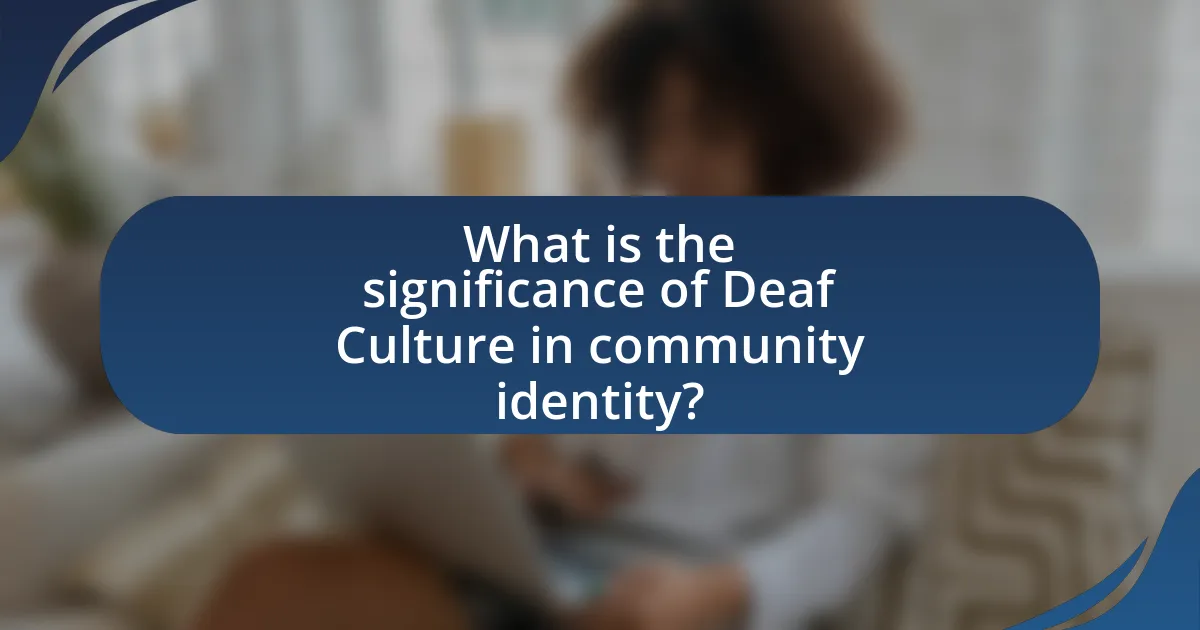
What is the significance of Deaf Culture in community identity?
Deaf Culture is significant in community identity as it fosters a unique sense of belonging and shared experiences among Deaf individuals. This culture encompasses distinct language, values, traditions, and social norms that create a cohesive community. For instance, American Sign Language (ASL) serves not only as a means of communication but also as a cultural cornerstone that reinforces identity and connection among its users. Research indicates that participation in Deaf cultural activities, such as storytelling and social gatherings, enhances social cohesion and strengthens community ties. Furthermore, the recognition of Deaf Culture promotes advocacy for rights and accessibility, which is essential for the empowerment and visibility of Deaf individuals within the broader society.
How does Deaf Culture shape the identity of individuals within the community?
Deaf Culture significantly shapes the identity of individuals within the community by fostering a shared language, values, and social norms that promote a sense of belonging. The use of American Sign Language (ASL) or other sign languages creates a unique linguistic identity that distinguishes Deaf individuals from hearing populations, reinforcing their cultural heritage. Additionally, Deaf Culture emphasizes visual communication, storytelling, and community events, which strengthen interpersonal connections and collective identity. Research indicates that participation in Deaf cultural activities enhances self-esteem and social cohesion among Deaf individuals, as evidenced by studies showing that those engaged in Deaf community events report higher levels of identity affirmation and social support.
What are the key elements that define Deaf Culture?
The key elements that define Deaf Culture include shared language, community values, social norms, and a collective identity. The use of American Sign Language (ASL) or other sign languages serves as a primary means of communication, fostering a unique linguistic community. Additionally, Deaf Culture emphasizes the importance of visual communication and storytelling, which are integral to social interactions and cultural expression. Community values such as inclusivity, pride in Deaf identity, and advocacy for rights and accessibility further strengthen the cultural framework. Historical experiences, such as the establishment of Deaf schools and organizations, contribute to a shared sense of identity and belonging among Deaf individuals.
How do shared experiences contribute to a sense of belonging in Deaf Culture?
Shared experiences significantly contribute to a sense of belonging in Deaf Culture by fostering community bonds and reinforcing cultural identity. These experiences, such as attending Deaf events, participating in sign language classes, or engaging in shared storytelling, create a collective understanding and appreciation of Deaf identity. Research indicates that communal activities enhance social connections, which are vital for emotional support and validation within the Deaf community. For instance, a study by Padden and Humphries highlights that shared cultural practices, including visual communication and storytelling traditions, strengthen interpersonal relationships and promote a cohesive community identity among Deaf individuals.
Why is understanding Deaf Culture important for broader societal integration?
Understanding Deaf Culture is crucial for broader societal integration because it fosters inclusivity and respect for diverse communication methods. Recognizing the values, norms, and experiences of the Deaf community enables society to create environments that accommodate and celebrate differences. For instance, studies show that inclusive practices, such as the use of sign language interpreters and Deaf awareness training, significantly improve interactions between Deaf and hearing individuals, leading to reduced social barriers and enhanced mutual understanding. This integration not only benefits the Deaf community but also enriches the overall social fabric by promoting diversity and empathy among all community members.
How does Deaf Culture challenge mainstream perceptions of communication?
Deaf Culture challenges mainstream perceptions of communication by emphasizing visual and gestural forms of interaction, which contrasts with the auditory-centric communication norms prevalent in hearing societies. This cultural framework prioritizes sign language as a legitimate and rich mode of communication, showcasing its complexity and depth, thereby redefining what constitutes effective communication. Research indicates that sign languages, such as American Sign Language, possess their own grammar and syntax, making them fully functional languages. This challenges the misconception that communication must be auditory to be valid, highlighting the importance of visual-spatial awareness and non-verbal cues in conveying meaning.
What role does advocacy play in promoting Deaf Culture within communities?
Advocacy plays a crucial role in promoting Deaf Culture within communities by raising awareness and fostering understanding of Deaf experiences and values. Through organized efforts, advocates work to dismantle stereotypes, promote accessibility, and ensure that Deaf individuals have a voice in cultural and social discussions. For instance, advocacy initiatives often lead to the implementation of sign language education in schools, which not only benefits Deaf students but also enriches the broader community’s understanding of Deaf Culture. Research indicates that communities with active advocacy groups report higher levels of inclusivity and participation from Deaf individuals, demonstrating the positive impact of advocacy on community identity and cohesion.
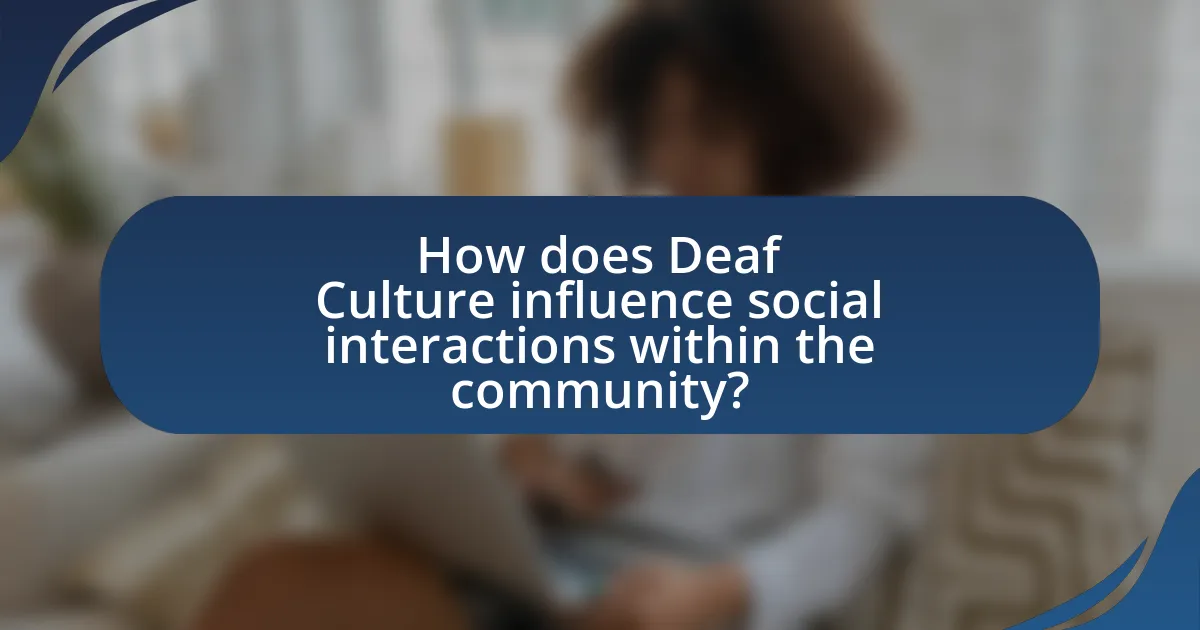
How does Deaf Culture influence social interactions within the community?
Deaf Culture significantly influences social interactions within the community by fostering a unique sense of identity and belonging among its members. This culture emphasizes visual communication, primarily through sign language, which enhances social bonding and facilitates deeper connections. For instance, gatherings such as Deaf clubs and events promote shared experiences and cultural pride, reinforcing community ties. Research indicates that participation in Deaf cultural activities leads to increased social cohesion and support networks, as evidenced by studies showing that Deaf individuals who engage in community events report higher levels of social satisfaction and emotional well-being.
What communication methods are prevalent in Deaf Culture?
Sign language is the primary communication method prevalent in Deaf Culture. American Sign Language (ASL) is widely used in the United States and Canada, while other countries have their own distinct sign languages, such as British Sign Language (BSL) and Auslan in Australia. These sign languages are fully developed languages with their own grammar and syntax, enabling effective communication among Deaf individuals. Research indicates that approximately 70 million people worldwide use sign language, highlighting its significance in fostering community identity and cultural connection within the Deaf community.
How does sign language serve as a cultural cornerstone for the Deaf community?
Sign language serves as a cultural cornerstone for the Deaf community by providing a unique means of communication that fosters identity and belonging. This visual language encapsulates the experiences, values, and traditions of Deaf individuals, enabling them to connect with one another on a profound level. Research indicates that sign language is not merely a tool for communication but also a vital component of cultural expression, as it includes idioms, storytelling, and humor specific to Deaf culture. For instance, the use of regional signs and variations reflects the diverse experiences within the community, reinforcing a shared identity. Furthermore, studies show that sign language promotes social cohesion and community engagement, as it allows Deaf individuals to participate fully in cultural events and gatherings, thereby strengthening their sense of belonging and cultural pride.
What are the social norms and values that govern interactions in Deaf Culture?
Social norms and values in Deaf Culture emphasize visual communication, community cohesion, and respect for individual identity. Deaf individuals prioritize face-to-face interactions, using sign language as the primary mode of communication, which fosters inclusivity and connection. Additionally, the culture values shared experiences and collective identity, often leading to strong community bonds. Respect for personal space and direct eye contact are also crucial, as they signify engagement and attentiveness. These norms are rooted in the historical context of Deaf communities, which have developed unique social practices to navigate a predominantly hearing world.
How do community events and gatherings reinforce Deaf Culture?
Community events and gatherings reinforce Deaf Culture by providing spaces for social interaction, cultural expression, and shared experiences among Deaf individuals. These events, such as Deaf festivals, sign language classes, and community meetings, facilitate the transmission of cultural values, traditions, and language, which are essential components of Deaf identity. For instance, the National Association of the Deaf reports that participation in community events fosters a sense of belonging and strengthens social networks, which are crucial for maintaining cultural continuity. Additionally, these gatherings often feature performances, storytelling, and art that highlight Deaf experiences, further solidifying the cultural identity within the community.
What types of events are significant for the Deaf community?
Significant events for the Deaf community include Deaf festivals, sign language competitions, and awareness campaigns. Deaf festivals, such as the Deaf Way and the National Association of the Deaf (NAD) conferences, celebrate Deaf culture and provide networking opportunities. Sign language competitions, like the American Sign Language (ASL) Poetry Slam, showcase artistic expression within the community. Awareness campaigns, such as Deaf Awareness Month, promote understanding and advocacy for Deaf rights. These events foster community identity and cultural pride, reinforcing the social and cultural bonds among Deaf individuals.
How do these events foster a sense of unity and identity?
Events within the Deaf community foster a sense of unity and identity by providing shared experiences that reinforce cultural values and social connections. These gatherings, such as Deaf festivals and sign language competitions, create opportunities for individuals to engage with one another, celebrate their heritage, and strengthen communal bonds. Research indicates that participation in culturally significant events enhances feelings of belonging and identity among community members, as evidenced by studies showing increased social cohesion and support networks within the Deaf population.
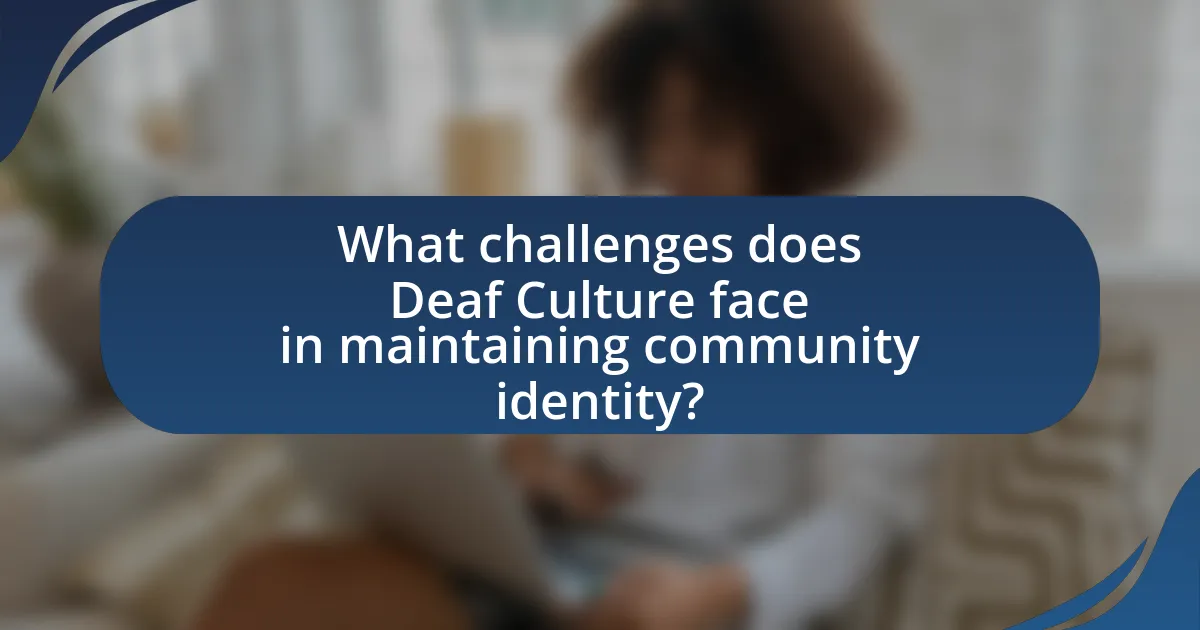
What challenges does Deaf Culture face in maintaining community identity?
Deaf Culture faces significant challenges in maintaining community identity primarily due to societal marginalization and the prevalence of oralism over sign language. The dominance of hearing culture often leads to a lack of understanding and acceptance of Deaf identity, which can result in isolation and disconnection among Deaf individuals. Additionally, the increasing use of technology and social media can dilute traditional Deaf practices and values, making it harder for the community to preserve its unique cultural heritage. Research indicates that the shift towards mainstream education and communication methods further exacerbates these challenges, as it can lead to a diminished use of sign language and a weakening of community bonds.
How does the prevalence of technology impact Deaf Culture?
The prevalence of technology significantly enhances Deaf Culture by facilitating communication and access to information. Technologies such as video relay services, instant messaging, and social media platforms enable Deaf individuals to connect with each other and the hearing world more effectively. For instance, the use of video calls allows for sign language communication in real-time, bridging gaps that traditional phone calls cannot. Additionally, the rise of social media has created virtual communities where Deaf individuals can share experiences, resources, and cultural content, thus reinforcing their identity and sense of belonging. Research indicates that these technological advancements have led to increased visibility and representation of Deaf Culture in mainstream media, further validating and enriching the community’s identity.
What are the benefits and drawbacks of technology for Deaf communication?
Technology for Deaf communication offers significant benefits and drawbacks. The primary benefit is enhanced accessibility, as tools like video relay services and text messaging facilitate real-time communication, allowing Deaf individuals to connect more easily with hearing people and each other. For instance, video conferencing platforms enable sign language interpretation, bridging communication gaps that previously existed.
Conversely, a notable drawback is the potential for over-reliance on technology, which may lead to reduced face-to-face interactions and the erosion of traditional Deaf culture. Additionally, not all Deaf individuals have equal access to technology due to socioeconomic disparities, which can create communication barriers rather than eliminate them. This duality highlights the complex impact of technology on Deaf communication, emphasizing the need for balanced integration that respects and preserves Deaf culture while leveraging technological advancements.
How can technology be leveraged to strengthen Deaf Culture?
Technology can be leveraged to strengthen Deaf Culture by enhancing communication, accessibility, and community engagement. Video relay services (VRS) and video conferencing platforms enable real-time communication in sign language, fostering connections among Deaf individuals and their hearing peers. Additionally, social media platforms provide spaces for sharing experiences, cultural expressions, and advocacy, which are vital for community identity. Research indicates that the use of mobile applications designed for Deaf users has increased access to information and resources, further promoting cultural awareness and participation. For instance, a study published in the Journal of Deaf Studies and Deaf Education highlights how technology facilitates social interaction and cultural exchange within the Deaf community, reinforcing its identity and cohesion.
What external factors threaten the preservation of Deaf Culture?
External factors that threaten the preservation of Deaf Culture include the dominance of oralism, technological advancements, and societal attitudes towards disability. Oralism, which emphasizes spoken language over sign language, undermines the use of sign language, a core component of Deaf identity. Technological advancements, while beneficial in some contexts, can lead to a reliance on devices that may diminish face-to-face communication and the use of sign language. Additionally, societal attitudes that marginalize or misunderstand Deaf individuals contribute to a lack of support for Deaf Culture, making it harder for the community to thrive. These factors collectively challenge the continuity and vibrancy of Deaf Culture within society.
How does societal ignorance affect the Deaf community’s identity?
Societal ignorance significantly undermines the Deaf community’s identity by perpetuating misconceptions and marginalization. This lack of understanding often leads to the devaluation of Deaf culture and language, such as American Sign Language, which are integral to the community’s identity. For instance, studies show that when society fails to recognize the legitimacy of Deaf culture, it can result in lower self-esteem and a diminished sense of belonging among Deaf individuals. Furthermore, the absence of awareness about Deaf experiences can lead to exclusion from social, educational, and professional opportunities, reinforcing stereotypes and limiting the community’s visibility. This cycle of ignorance not only affects individual identity but also hinders the collective identity of the Deaf community, making it crucial for society to foster awareness and appreciation of Deaf culture.
What measures can be taken to combat these challenges?
To combat the challenges faced by Deaf culture in community identity, promoting inclusive education and awareness programs is essential. These initiatives can help bridge communication gaps and foster understanding among hearing individuals and the Deaf community. Research indicates that inclusive educational settings improve social interactions and reduce stigma, as seen in studies conducted by the National Deaf Center on Postsecondary Outcomes, which highlight the benefits of early exposure to Deaf culture in schools. Additionally, advocating for policy changes that support accessibility in public spaces and media can further empower the Deaf community, ensuring their cultural identity is recognized and valued.
What practical steps can individuals take to support Deaf Culture in their communities?
Individuals can support Deaf Culture in their communities by actively promoting and participating in Deaf events and activities. Engaging in local Deaf festivals, workshops, and social gatherings fosters awareness and appreciation of Deaf Culture. Additionally, individuals can learn American Sign Language (ASL) or other sign languages to communicate effectively with Deaf individuals, enhancing inclusivity. Supporting Deaf-owned businesses and advocating for accessibility in public spaces, such as ensuring that events have sign language interpreters, further strengthens community ties. Research indicates that communities with active Deaf participation experience greater cultural diversity and social cohesion, highlighting the importance of these practical steps.


